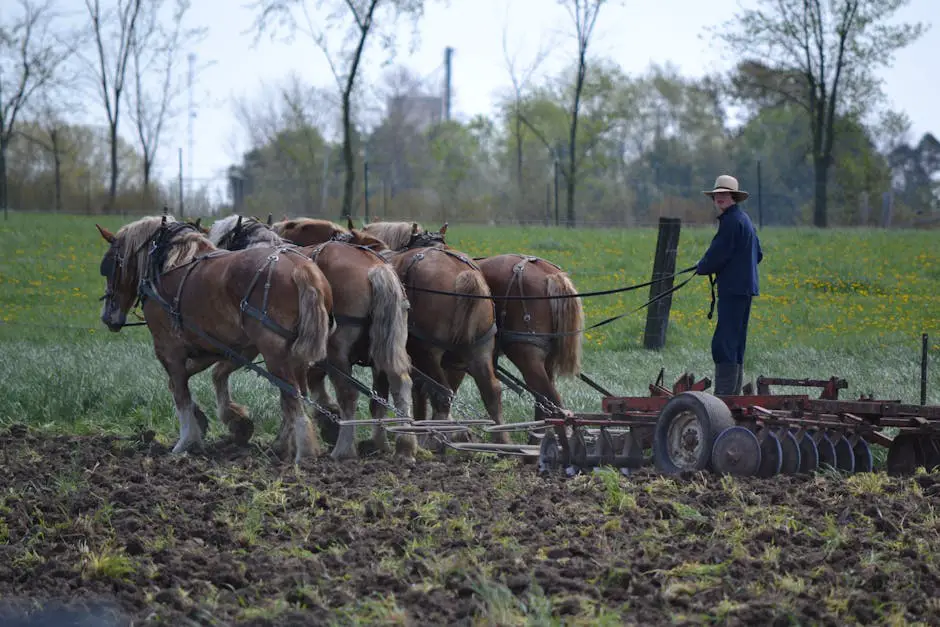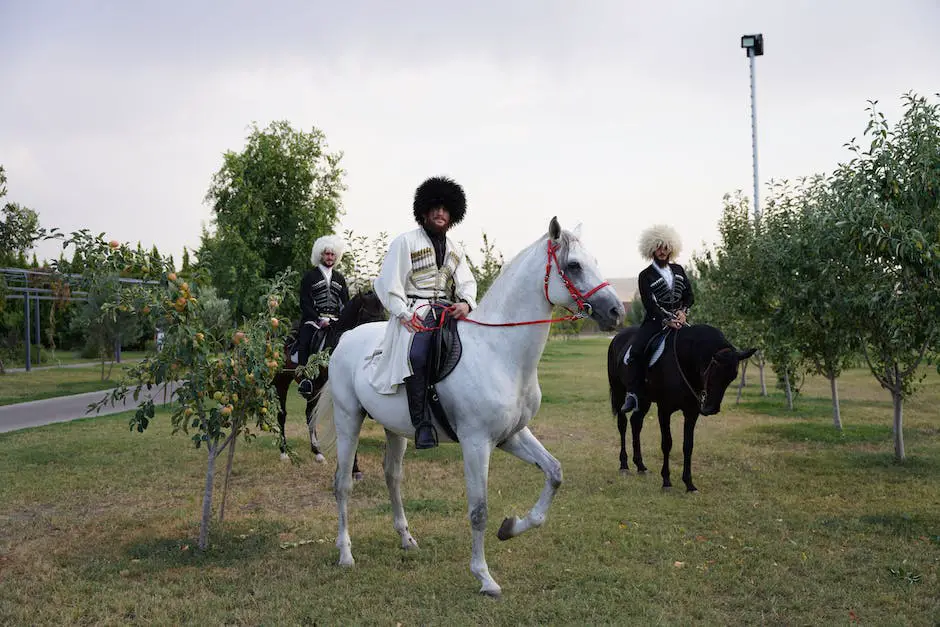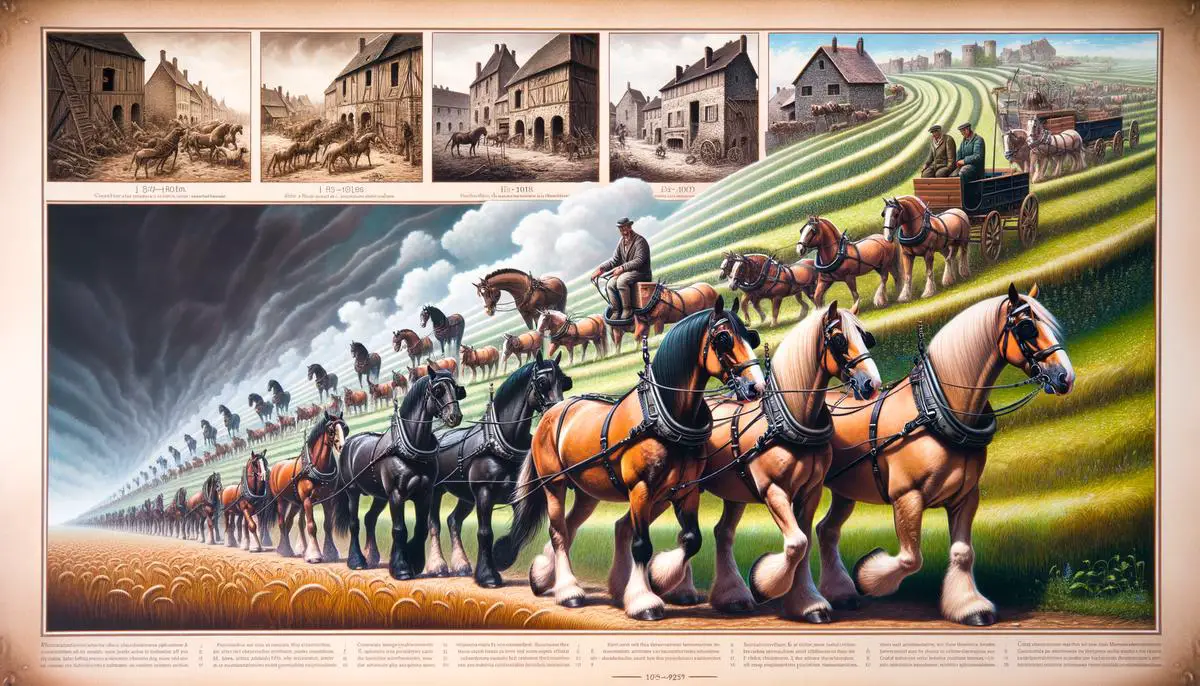The majestic draft horses of France stand as a testament to the nation’s historical relationship with these powerful creatures, whose hoof beats have echoed through the fields and hearts of the countryside for centuries. As we embark on an exploration of the History and Evolution of French Draft Horses, we witness a story not merely about equine development but of human progress, agriculture innovation, and cultural identity intertwined with the thunderous gallop of the Percheron and its kin. Within the tapestry of France’s past, these draft breeds emerge as pivotal characters, shaped by the hands of selective breeders and the needs of the times. Our journey through this equine heritage promises insight into how the destinies of humans and horses are forever entwined.
Table of Contents (Horspedia)
History and Evolution of French Draft Horses
Mighty Muscle: The Role of French Draft Horses in Agricultural History
Let’s talk about the brawny giants of agriculture: French draft horses. These equine powerhouses have been more than just a pretty face in the farm fields; they’ve been the engine of agriculture throughout history, especially before the tractor era. Among the draft breeds, the French drafts—like the Percheron, the Breton, and the Normandy—have a tale all their own.
In Europe, before these tractors and combines rolled into the picture, horsepower vividly meant the strength of horses. French draft horses, in particular, were the heavy lifters. Let’s start with the Percheron—probably the most famous of the French draft breeds. Originating from the Perche region of France, these horses are basically the bodybuilders of the equine world. What makes them stand out? They’ve got strength, endurance, and can move with a surprising gracefulness for their size.
Now, swing by the farms of historical France, and you would see Percherons doing the tough work: plowing fields, hauling heavy loads, and basically being the tractors of their day. Farmers depended on these sturdy animals to transform the agricultural landscape, quite literally, from the ground up. With their help, vast stretches of land could be farmed efficiently, which meant more food on the table, more goods to trade, and a steadier economy.
But it’s not just about muscle. The Breton breed, coming from Brittany, has also been a game-chopper in the fields. These compact, muscular horses are known for their stamina and quick recovery. Picture the Breton as the marathon runners: they might not have the outright size of the Percheron, but their endurance made them perfect for long days of work with the plow and cart.
And then there’s the hardy Normandy breed, which emerged as the jack-of-all-trades on small farms. They might not have been as heavy as other draft breeds, but their versatility was and still is, cherished. Farmers could rely on these horses for all sorts of tasks, making the most of their day and their land.
Let’s also touch on the fact that these horses were not just muscle; they were smart. Over time, these horses became attuned to farm life, to the farmers’ commands, and the rhythms of agricultural seasons—a detail that shouldn’t be overlooked. The intelligence and trainability of French draft horses meant they could be led to perform complex tasks, increasing their value and the productivity of their work.
Even though tractors and modern machinery have largely taken over the heavy lifting in agriculture, French draft horses left a hoofprint that can’t be erased. They shaped how areas were farmed, allowed for larger-scale farming, and inspired a transition into modern agriculture, which many still benefit from today.
So, while the fields may not be filled with French draft horses like they used to be, their impact on agricultural history stands as tall and strong as the horses themselves—proving, once again, the incredible power and influence of the animal kingdom, or in this case, the original horsepower. If you’ve ever admired these colossal creatures up close or recognized the depth of their historical role, you’ll understand the monumental respect they command to this day.

Characteristics and Breeds of French Draft Horses
The Diverse Charisma of French Draft Horse Breeds
French draft horses, well-known for their strength and elegance, are more than majestic giants. Each breed has an array of unique traits that make them stand out not just in history, but also in modern-day tasks and leisure activities.
Moving on from the notable Percheron, Breton, and Normandy breeds, let’s dive into the distinctive features of other French drafts.
The Auxois: A Mighty Blend
With roots that trace back to the illustrious Percheron and the now-extinct Bourguignon horse, the Auxois breed touts a robust physique suitable for heavy-duty work. Distinct for its deep chest, powerful hindquarters, and a somewhat shorter stature when compared to the lofty Percheron, the Auxois is a prime example of raw power. Traditionally used for plowing and heavy farm work, today’s Auxois often finds itself at the center of attention in draft horse shows, parading its red-roan or bay coat with pride.
The Trait du Nord: A Gentle Giant
Characteristic thick legs and a gentle demeanor define the Trait du Nord. Originating from the northern regions of France, this breed is slightly smaller in size but no less capable. Their calmness under pressure shines in agricultural tasks and they adore interactions with people, making them fantastic for educational farm visits.
The Poitevin Mulassier: A Versatile Partner
The Poitevin Mulassier, known for its role in mule production, is a serene behemoth with a calm nature that makes it a solid companion for delicate tasks. Though its population is smaller, conservation efforts celebrate its bay or dun coats and kind eyes.
The Boulonnais: The Marble Horse
Easily identifiable by its iridescent grey coat that shimmers like marble, the Boulonnais horse is a true beauty with brawn. Smoother curves and refined conformation have earned it accolades as a ‘draft horse in porcelain.’ Thriving on the coastlines where it once hauled fishing nets, the Boulonnais now graces show rings and ceremonial duties with an air of nobility.
The world of French draft horses is an intricate tapestry woven with strength, grace, and a remarkable range of skills. As they evolve from their historical roles to more diverse contemporary engagements, their unique traits continue to shine bright, reminding us of the depth and character these magnificent animals bring to the equestrian realm. From hauling to heart-stealing, they are a testament to the timeless bond between humans and horses.

Caring for Draft Horses
Draft Horse Care and Management Essentials
Caring for draft horses, the gentle giants of the equine world, is both a rewarding and demanding experience. Given their size and strength, they have unique needs compared to their lighter equine counterparts. This segment dives into the essentials of draft horse care and management to ensure these majestic animals lead healthy, happy lives.
Nutrition Matters: Feeding Your Draft Horse
Nutrition is the foundation of draft horse health. Due to their size, these horses require a diet that caters to their caloric needs while preventing obesity. High-quality forage, like hay or pasture grass, should make up the bulk of their diet—around 1 to 2 percent of their body weight. Grains can be a source of extra calories if needed, but it’s vital to balance the diet to avoid causing digestive or metabolic issues.
Regular Exercise: Keeping the Muscles Moving
Adequate exercise is critical for draft horses. Though their work on farms has decreased with modern machinery, these horses still need regular activity to maintain muscle tone and prevent health issues like laminitis or joint problems. Incorporating a mix of training exercises, trail rides, or light work tasks can keep them in good shape.
Healthcare: Prevention is Better than Cure
Draft horses require regular veterinary care, including vaccinations, deworming, and dental checkups. Since they’re prone to certain conditions like Equine Polysaccharide Storage Myopathy (EPSM), it’s vital to work with a vet who understands draft-specific health risks. Preventative care is key—spotting a problem early can make all the difference.
Hoof Care: A Solid Foundation
These horses carry more weight, which puts additional pressure on their hooves. Regular trimming and, if necessary, shoeing are non-negotiable tasks. Failure to maintain hoof care can lead to a host of problems, including lameness. A farrier experienced with draft breeds should be part of one’s horse care team.
Living Space: Comfortable, Safe Surroundings
Draft horses need more space—not just in their stalls, which should be larger to accommodate their size, but also in doorways, aisles, and trailers. Fences should be strong and taller to prevent these powerful animals from leaning over and potentially breaking them. Clean, dry bedding is essential for comfort and health.
Socialization: The Sociable Giants
Like all equines, draft horses are social animals and thrive on interaction. Ensuring they have equine companionship can prevent behavioral issues associated with isolation. Bonding with human caretakers through grooming and handling also fosters trust and a strong human-horse relationship.
Weather Considerations: Protecting the Majestic Beast
Draft horses are hardy but still need protection from extreme weather. In winter, they may require extra forage and water that isn’t freezing cold, while in hot climates, shade and plenty of water are essential to avoid overheating. Adjust their care routine according to the seasons.
Grooming: More Than Just an Aesthetic
Regular grooming keeps the skin and coat in good condition, but for draft horses, it’s also an opportunity to check for wear from harnesses or signs of any skin conditions that their thick coats might hide. Special attention should be given to their feathers, the long hairs on their lower legs, to prevent mites and other issues.
Embarking on the journey of caring for a draft horse is a lifetime commitment that will be filled with immense satisfaction. These stunning breeds, built for power and endurance, deserve no less than the best care we can provide. In return, they offer strength, grace, and a partnership that echoes through the ages. Remember, the journey with these equine partners is as rich as their history—treat them well, and they will do the same for you.

Photo by patwhelen on Unsplash
Embracing the grandeur and nobility of France’s draft horses, our journey through time, breed specifics, and meticulous care regimens culminates in a deeper appreciation for these equine marvels. From the powerful Percheron to the hardy Breton, each breed carries a unique legacy that continues to influence present-day practices in agriculture and beyond. As stewards of these magnificent animals, it remains our profound duty and privilege to ensure that their lineage is preserved, their well-being prioritized, and their contributions to humanity celebrated. Through our dedication to understanding and caring for these giants, we honor a tradition as enduring as the draft horses themselves—a tradition that commands respect and inspires awe in equal measure.
